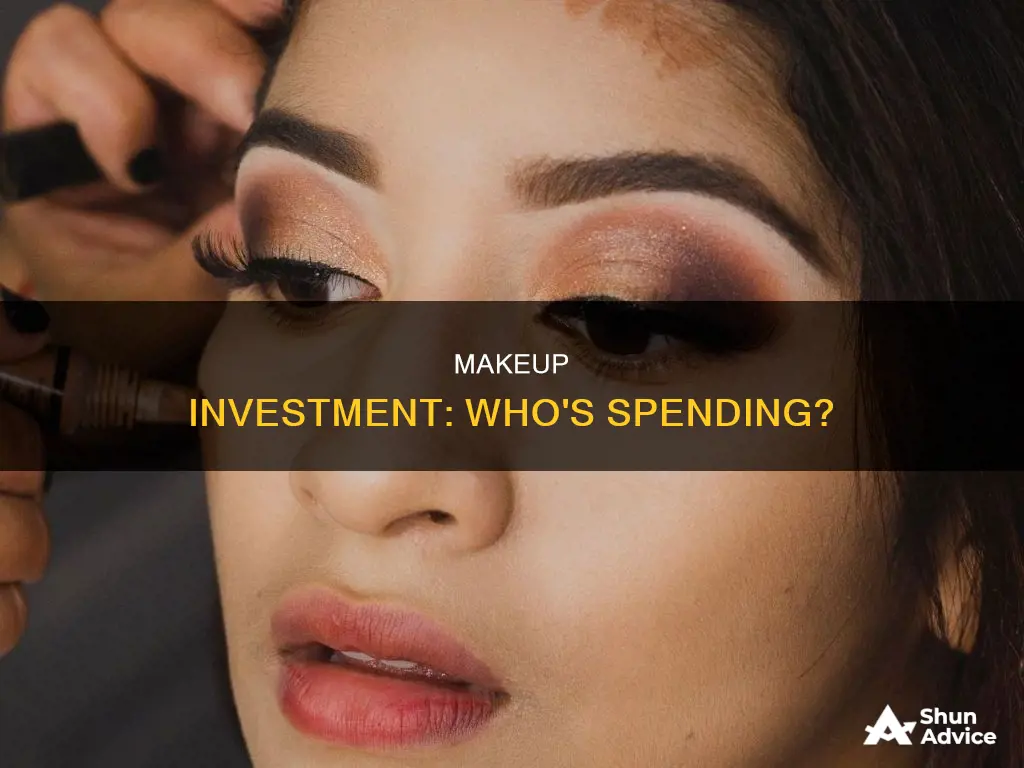
Makeup is big business. The beauty industry generates over $100 billion in revenue worldwide, with the US spending the most at $89.7 billion annually. American women spend an average of $3,756 per year on beauty products and services, with makeup, skincare and haircuts being the top three spending categories. Men are also increasingly investing in their appearance, with the men's personal care market projected to hit $276.9 billion by 2030. The beauty industry has seen a boost during tough economic times, as people indulge in affordable luxuries like lipstick. Social media has also played a huge role in the industry's growth, with beauty influencers having a huge impact on consumer behaviour.
What You'll Learn

Millennial women are the top buyers of beauty products
The beauty industry generates over $100 billion in revenue worldwide, and it's the millennial women, aged 18-34, who are the main buyers. Spending nearly $13 billion in the cosmetics industry, they are the heaviest buyers of colour cosmetics, with 32% of women aged 18-24 and 26% of women aged 25-34 purchasing 10 or more types of colour cosmetics per year. This is compared to 20% of women overall.
Millennial women are driving the growth of smaller brands, rejecting traditional labels in favour of independent brands. They are also more likely to buy online, with 85% agreeing that they will buy a product they like wherever they can get the best price. However, the Harris Poll survey found that millennials are most likely to buy items in person from big-box retail stores, with Sephora being the third most popular way to purchase beauty items. This is due to the "try before buying" concept that online shopping cannot offer.
Millennial women are also the most likely to participate in direct-to-consumer trends, such as sample boxes and individual lines. This is partly because this demographic is highly attuned to finding a "great deal" after doing extensive research. They are also leading the trend towards healthy and clean products, with 72% of respondents in an AlixPartners survey saying it was important to purchase healthy or clean products. This is driven by a growing awareness of the ingredients in beauty and personal care products, with consumers being warned by the media of certain ingredients to avoid.
Millennial women are a powerful force in the beauty industry, with their purchasing behaviour and preferences shaping the market. They seek authenticity, self-expression, and natural or organic ingredients, and their influence is only expected to grow.
Young Investors: Who and How Many?
You may want to see also

Beauty brands are investing in digital advertising
The beauty industry is a billion-dollar industry, generating over $100 billion in revenue worldwide. In the US alone, the industry recorded an estimated revenue of $50 billion in 2022. With the industry's focus on connecting with customers and expanding product lines, beauty brands are investing heavily in digital advertising.
In the past, the beauty industry preferred traditional advertising channels like television and magazines. However, with consumers increasingly opting for online shopping, the industry is shifting its ad spend online. By 2021, the internet was expected to account for half of the beauty industry's total global ad spend, while ad spend in magazines and TV continued to decline. This shift towards digital advertising is even more prominent among beauty brands targeting younger consumers, as Gen Z and younger millennials are more likely to be influenced by social media and online content.
Digital advertising now makes up around one-third of the total ad spend in the beauty industry. Beauty brands are utilising various digital channels, including Google Ads, social media platforms like Facebook, Instagram, TikTok, and YouTube, as well as email marketing campaigns. Social media platforms, in particular, have become a key focus for beauty brands, as they offer a visual medium to showcase their products and build a loyal online following.
While television remains the predominant advertising medium for cosmetics and personal care products, the shift towards digital advertising is undeniable. Beauty brands are recognising the importance of adapting to changing consumer behaviours and are investing in digital advertising to increase their exposure, build a stronger online presence, and ultimately drive sales.
Stable Interest Rates: Investors' Confidence Boost?
You may want to see also

Beauty is an affordable luxury
In the past, luxury beauty products were primarily associated with high price tags and exclusive accessibility. However, the beauty landscape has become more fluid, blurring the boundaries between traditional retail channels and reshaping the definition of luxury. Now, luxury is not solely determined by price but by performance and efficacy. Consumers are increasingly seeking out products that deliver on their promises, regardless of whether they are prestige or affordable brands.
This shift in perception has led to a growing trend of 'affordable luxury' in the beauty industry. Retailers are mixing up their offerings, with premium department stores like Harrods and Selfridges stocking budget-friendly brands such as The Ordinary and The Inkey List alongside high-end labels. Similarly, mass-market retailers like Walmart have started partnering with prestige beauty brands, making luxury more accessible to a wider range of consumers.
The affordability of luxury beauty is further enhanced by the growing influence of beauty influencers and the rise of e-commerce. Beauty influencers have massive followings on social media, with around 4 in 5 beauty shoppers using Instagram daily and turning to influencers to discover new products. This provides an opportunity for consumers to learn about affordable alternatives to high-end products. Additionally, the convenience of online shopping and the increasing availability of user-generated content and reviews on brand websites enable consumers to make informed decisions about their purchases, ensuring they get the best value for their money.
The notion of affordable luxury is particularly evident in the skincare category. With skincare representing a significant portion of the beauty market, brands are catering to diverse consumer needs by offering a range of price points. While large companies like Estée Lauder continue to dominate, niche brands are also finding success by targeting specific consumer segments with tailored, affordable products. Consumers are increasingly investing in their skincare routines, seeking out cleansers, moisturisers, and anti-aging solutions that offer high-quality results without compromising their budgets.
Affordable luxury in beauty is about meeting everyone's needs and budgets. Whether it's sun protection, hair care, skincare, or captivating fragrances, there is a growing selection of curated, budget-friendly products available. For example, Sephora offers exclusive deals on various beauty items, such as the Shiseido Ultimate Sun Protector Face and Body Lotion SPF 60+ for $25 and the Rare Beauty by Selena Gomez Soft Pinch Luminous Powder Blush for $26.
In conclusion, beauty is indeed an affordable luxury in today's market. With a diverse range of options, consumers can indulge in luxury beauty experiences without breaking the bank. The focus on performance, efficacy, and accessibility has empowered consumers to make choices that align with their individual needs and financial situations. As the beauty industry continues to evolve, the definition of luxury will continue to be reshaped, ensuring that beauty remains an affordable indulgence for all.
Rich People: The Only Investors?
You may want to see also

Beauty brands are partnering with influencers
The beauty industry is a lucrative market, generating over $100 billion in revenue worldwide. It's no surprise that brands are partnering with influencers to promote their products. In fact, 74% of Gen Z and 66% of millennials make purchases based on what they see beauty influencers post. This has led to a surge in consumer spending on beauty products, with the cosmetics industry alone expected to grow by $20+ billion in the next four years.
Influencers have become essential for beauty brands to earn stunning content and increase their marketing reach. By partnering with influencers, brands can tap into the influencer's existing follower base and extend their reach to a target demographic. Beauty influencers also help to create entertaining and trend-forward content, as they are closely attuned to industry trends. This allows brands to engage in viral moments and craft content that resonates with followers, leading to higher engagement rates.
Additionally, influencers boost a brand's authenticity and credibility. Their endorsements are often seen as more genuine and trustworthy by their followers. They can create relatable and engaging content that humanizes the brand, making it more appealing and trustworthy to the audience.
There are several ways in which beauty brands can collaborate with influencers. One way is through sponsored content, where the influencer creates authentic reviews, tutorials, or promotional content for the brand. Brands can also send products to influencers to feature in their content, allowing users to see the application of the product and how it looks in a full routine. Beauty brands can also partner with influencers to showcase their efforts in sustainability and the use of clean and ethical ingredients.
Some beauty brands that have successfully utilized influencer marketing include Glossier, Morphe, NYX, ColourPop, and Kylie Cosmetics. These brands have tapped into the power of social media and influencer partnerships to increase their brand awareness and sales.
Overall, the beauty industry's partnership with influencers is a mutually beneficial relationship that helps brands connect with their target audience and drive sales, while providing influencers with a platform and compensation for their content.
Middle-Aged Investors: Saving Enough?
You may want to see also

Beauty is a creative outlet for many
For some, makeup is not just about enhancing their physical appearance but also about celebrating their true selves. It serves as a tool for self-expression and creativity, allowing individuals to be bold and unique. Many people, especially women, invest a significant amount of time and money in their beauty routines, with American women spending an average of $3,756 per year on beauty products and services. This includes haircuts, makeup, and skincare, with an average daily spending of just over $10.
Makeup enthusiasts and brands have taken to social media platforms like Instagram to showcase their creativity. They collaborate with influencers, share tutorials, and engage with their audiences in new and innovative ways. Social media has become a powerful tool for the beauty industry, with brands investing billions in advertising to connect with their customers.
Makeup can also be a source of strength and confidence. It can be a way to stand out, make a statement, and showcase one's opinions. For some, it is a form of art, with different colours, techniques, and tools used to create unique looks. From contouring to winged eyeliner, individuals can experiment and express themselves through makeup.
Additionally, makeup can be therapeutic for many. The process of buying and applying makeup can be enjoyable and provide a sense of self-care. It can also be a way to connect with others, such as friends experimenting with different looks or sharing tips and tricks.
In conclusion, beauty is indeed a creative outlet for many. It allows individuals to express themselves, showcase their personalities, and connect with others. The beauty industry, including the makeup sector, continues to grow and evolve, providing endless opportunities for creativity and self-expression.
Who Really Knows How to Invest?
You may want to see also
Frequently asked questions
On average, Americans spend between $244 and $313 on cosmetics every month. American women spend on average $313 a month on cosmetics, while American men spend around $244 a month.
Beauty companies spent an estimated $7.7 billion on advertising in 2022. Digital advertising makes up about a third of the total ad spend in the beauty industry.
The beauty industry generates over $100 billion in revenue worldwide. It is expected to reach $579.20 billion in 2023 and top $716 billion by 2025.
L'Oreal is the leading beauty products company with over $40 billion in global sales. Other top players include Unilever, Estee Lauder, P&G, and Shiseido.







